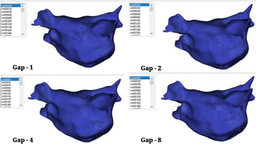Clinical Utility of Digital Twin-Guided Amiodarone Test in AF Patients
Published in Bioengineering & Biotechnology, Protocols & Methods, and General & Internal Medicine

Read the paper
https://doi.org/10.1038/s41746-024-01298-z
Advancement of Digital Twin Technology in Medicine
With rapid digital advancements, medicine increasingly leverages innovative tools to personalize patient care. The digital twin, a virtual replica of a patient’s organ, offers a unique advantage in assessing complex medical phenomena under controlled settings. This study focuses on atrial fibrillation (AF) and utilizes digital twin technology to predict the efficacy of amiodarone, an anti-arrhythmic drug (AAD), in patients post-AF ablation.
Main Findings
In this research, digital twins of the human left atrium were developed for 115 AF patients using computed tomography (CT) and electroanatomical mapping (EAM) data, enabling virtual AF induction and amiodarone simulation across various concentrations. By adjusting the ion channel conductivities in this model, we observed changes in action potential duration (APD) and peak upstroke velocity, simulating therapeutic amiodarone effects. Patients were divided into effective and ineffective groups based on AF or atrial tachycardia (AT) maintenance in the model, with outcomes showing a lower recurrence rate in the effective group after one year after antiarrhythmic drug use.
Limitations
We had several limitations, including its single-center design and restricted modeling of atrial structures. We acknowledged the need for enhanced non-invasive data integration and improved model precision for broader clinical applications in managing AF.
Conclusion
The digital twin-guided virtual amiodarone test demonstrated a promising approach to predicting drug efficacy in AF management. This patient-specific model allowed for simulating individual responses to amiodarone by adjusting ion channel properties within the digital twin, leading to actionable insights for rhythm control. Patients identified as responsive in the virtual setting showed a significantly lower one-year recurrence rate of AF/AT. This finding underscores the potential of digital twin technology in guiding personalized treatment plans and optimizing drug choice, enhancing rhythm control outcomes while minimizing unnecessary exposure to medications with limited efficacy.
Future Work
Moving forward, we plan to expand digital twin applications to other anti-arrhythmic drugs beyond amiodarone, developing predictive models tailored to various drug mechanisms. Additionally, we aim to integrate artificial intelligence (AI) and non-invasive imaging techniques, which could streamline digital twin construction and reduce reliance on invasive procedures. Prospective multicenter trials are essential for validating the predictive power of digital twin-guided virtual drug testing, with the goal of establishing it as a powerful tool in AF management and preventive cardiology.
Follow the Topic
-
npj Digital Medicine

An online open-access journal dedicated to publishing research in all aspects of digital medicine, including the clinical application and implementation of digital and mobile technologies, virtual healthcare, and novel applications of artificial intelligence and informatics.
Related Collections
With Collections, you can get published faster and increase your visibility.
Artificial Intelligence in Emergency and Critical Care Medicine
Publishing Model: Open Access
Deadline: Jan 10, 2026
Evaluating the Real-World Clinical Performance of AI
Publishing Model: Open Access
Deadline: Jun 03, 2026


Please sign in or register for FREE
If you are a registered user on Research Communities by Springer Nature, please sign in